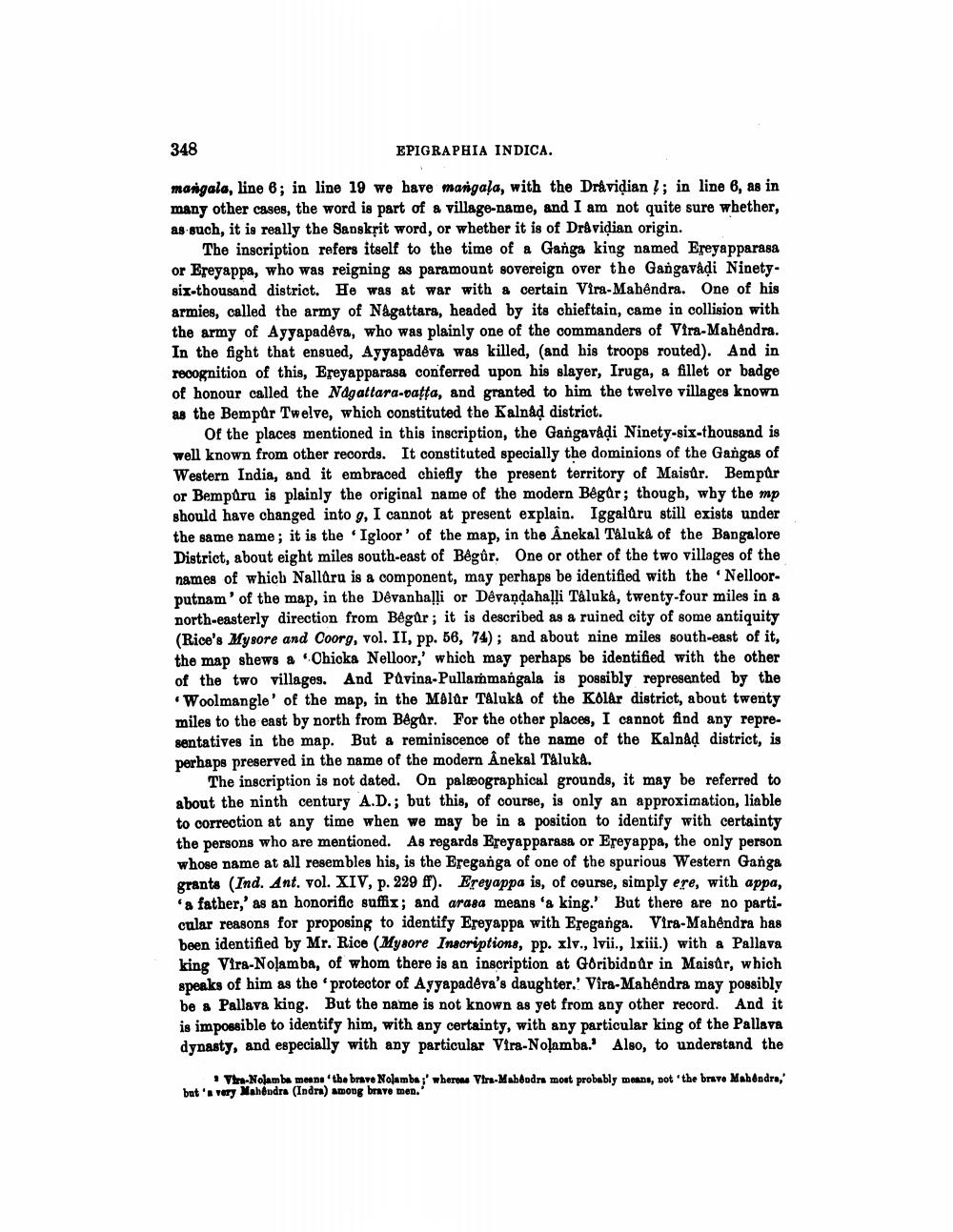________________
348
EPIGRAPHIA INDICA.
mangala, line 6; in line 19 we have mangala, with the Dravidian !; in line 6, as in many other cases, the word is part of a village-name, and I am not quite sure whether, as such, it is really the Sanskrit word, or whether it is of Dravidian origin.
The inscription refers itself to the time of a Ganga king named Ereyapparasa or Ereyappa, who was reigning as paramount sovereign over the Gangavadi Ninetysis-thousand district. He was at war with a certain Vira-Mahendra. One of his armies, called the army of Nagattara, headed by its chieftain, came in collision with the army of Ayyapadēva, who was plainly one of the commanders of Vira-Mahendra. In the fight that ensued, Ayyapadeva was killed, (and his troops routed). And in recognition of this, Ereyapparasa conferred upon his slayer, Iruga, a fillet or badge of honour called the Nagattara-patta, and granted to him the twelve villages known as the Bempur Twelve, which constituted the Kalnad district.
Of the places mentioned in this inscription, the Gangavåại Ninety-six-thousand is well known from other records. It constituted specially the dominions of the Gangas of Western India, and it embraced chiefly the present territory of Maisûr. Bempär or Bempuru is plainly the original name of the modern Begür; though, why the mp should have changed into g, I cannot at present explain. Iggaluru still exists under the same name; it is the Igloor of the map, in the Ânekal Taluka of the Bangalore District, about eight miles south-east of Bêgûr. One or other of the two villages of the names of whicb Nallaro is a component, may perhaps be identified with the Nelloorputnam' of the map, in the Dêvanhalli or Dêvandahalli Taluka, twenty-four miles in a north-easterly direction from Begur; it is described as a ruined city of some antiquity (Rice's Mysore and Coorg, vol. II, pp. 56, 74); and about nine miles south-east of it, the map shews a Chicka Nelloor,' which may perhaps be identified with the other of the two villages. And Pavina-Pullammangala is possibly represented by the
Woolmangle of the map, in the Malar Taluka of the Kolar district, about twenty miles to the east by north from Begur. For the other places, I cannot find any representatives in the map. But a reminiscence of the name of the Kalnad district, is perhaps preserved in the name of the modern Ånekal Taluka.
The inscription is not dated. On palæographical grounds, it may be referred to about the ninth century A.D.; but this, of course, is only an approximation, liable to correction at any time when we may be in a position to identify with certainty the persons who are mentioned. As regards Ereyapparasa or Ereyappa, the only person whose name at all resembles his, is the Ereganga of one of the spurious Western Ganga grants (Ind. Ant. vol. XIV, p. 229 ff). Ereyappa is, of course, simply ere, with appa, 'a father,' as an honorific suffix; and arasa means 'a king.' But there are no particular reasons for proposing to identify Ereyappa with Ereganga. Vira-Mahendra has been identified by Mr. Rice (Mysore Inscriptions, pp. xlv., lvii., lxiii.) with a Pallava king Vira-Nolamba, of whom there is an inscription at Goribidoar in Maisûr, which speaks of him as the protector of Ayyapadeva's daughter. Vira-Mahendra may possibly be a Pallava king. But the name is not known as yet from any other record. And it is impossible to identify him, with any certainty, with any particular king of the Pallava dynasty, and especially with any particular Vira-Nolamba.' Also, to understand the
Vin-Nolambe mens 'the brave Nolambai' whereas Vin-Mabeodre most probably means, not the brave Mahendra, but 's very Mahendra (Indra) among brave men.




